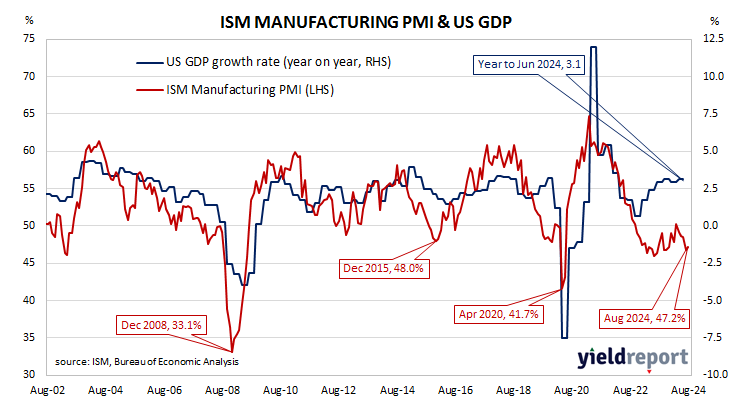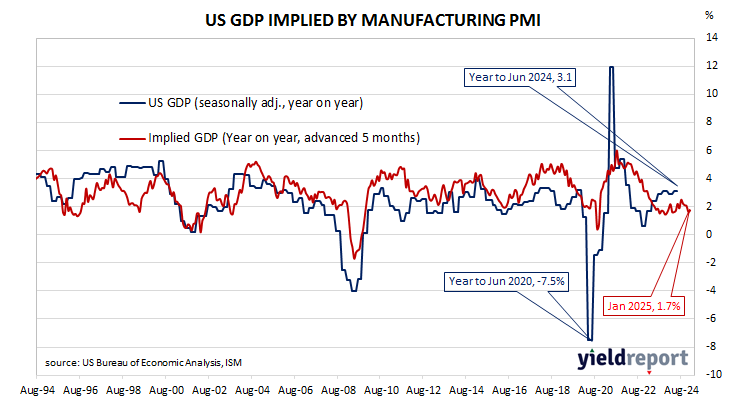Summary: ISM manufacturing PMI up in August, below expectations; Westpac: below 50 for all but one of past 22 months; US Treasury yields fall; expectations of Fed rate cuts firm; ANZ: manufacturing a rate sensitive sector; ISM: reading corresponds to 1.3% US GDP growth annualised.
The Institute of Supply Management (ISM) manufacturing Purchasing Managers Index (PMI) reached a cyclical peak in September 2017. It then started a downtrend which ended in March 2020 with a contraction in US manufacturing which lasted until June 2020. Subsequent month’s readings implied growth had resumed, with the index becoming stronger through to March 2021. Readings then declined fairly steadily until mid-2023 and have since generally stagnated.
According to the ISM’s August survey, its PMI recorded a reading of 47.2%, below the generally expected figure of 48.1% but above July’s 46.8%. The average reading since 1948 is roughly 53.0% and any reading below 50% implies a contraction in the US manufacturing sector relative to the previous month.
“The headline index has now been below 50 for all but one of the past 22 months,” said Westpac economist Illiana Jain. “New orders deteriorated, falling from 47.4 to 44.6 for its 25th reading below 50 of the past 28 months.”
US Treasury bond yields fell noticeably across a slightly flatter curve on the day. By the close of business, the 2-year Treasury bond yield had lost 5bps to 3.87%, the 10-year yield had shed 8bps to 3.83% while the 30-year yield finished 7bps lower at 4.13%.
In terms of US Fed policy, expectations of a lower federal funds rate in the next 12 months firmed, with eight 25bp cuts currently factored in. At the close of business, contracts implied the effective federal funds rate would average 5.19% in September, 4.725% in November and 4.505% in December. August 2025 contracts implied 3.295%, 203bps less than the current rate.
“Manufacturing is a rate sensitive sector because consumers often borrow to buy manufactured items; cars, electronics, white goods et cetera,” said ANZ senior economist Catherine Birch. “Producers will be hoping upcoming rate cuts boost the sector’s fortunes.”
Purchasing managers’ indices (PMIs) are economic indicators derived from monthly surveys of executives in private-sector companies. They are diffusion indices, which means a reading of 50% represents no change from the previous period, while a reading under 50% implies respondents reported a deterioration on average. A reading “above 42.5%, over a period of time, generally indicates an expansion of the overall economy”, according to the ISM’s latest calculations.
The ISM’s manufacturing PMI figures appear to lead US GDP by several months despite a considerable error in any given month. The chart below shows US GDP on a “year on year” basis (and not the BEA annualised basis) against US GDP implied by monthly PMI figures.
According to the ISM and its analysis of past relationships between the PMI and US GDP, August’s PMI corresponds to an annualised growth rate of 1.3%, or about 0.3% over a quarter. Regression analysis on a year-on-year basis suggests a 12-month GDP growth rate of 1.7% five months after this latest report.
The ISM index is one of two monthly US PMIs, the other being an index published by S&P Global. S&P Global produces a “flash” estimate in the last week of each month which comes out about a week before the ISM index is published. The S&P Global August flash manufacturing PMI registered 48.0%, down 1.6 percentage points from July’s final figure.



